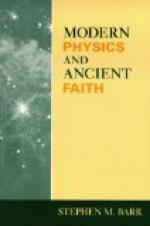The Hindu physics goes much farther along this road. It says that, when the pranic globes were formed, each atom of prana had its manasic envelope—was the center of a manasic molecule. When the etheric globes formed, each atom of ether was the center of a pranic molecule, each atom of which was surrounded with manasa. When the prakriti was formed from the ether, each and every atom of prakriti had the triple etheric-pranic-manasic envelope. “Each and every prakritic atom is the center of an etheric molecule,” says our Western science; but that of the East adds this: “And each atom of that etheric molecule is the center of a pranic molecule, and each atom of prana in that pranic molecule is the center of a manasic molecule.” The four great globes of matter in the material universe are represented and reproduced in each and every atom of prakriti, which is in touch with each one of the four globes and a part of it. The same is true of any aggregation of prakriti—of the earth itself and of all things in it, including man. As there are four atoms in each one, so there are four earths, four globes, consubstantial, one for each of the four elements, and in touch with it. One is formed of prakritic atoms—the globe we know; another, of the ether forming their envelopes; another, of the prana envelopes of ether, and a fourth of the manasa around the pranic atom. They are not “skins”; they are consubstantial. And what is true of atoms or globes is true of animals. Each has four “material” bodies, with each body on the corresponding globe —whether of the earth or of the Universe. This is the physical basis of the famous “chain of seven globes” that is such a stumbling-block in Hindu metaphysics. The spirit passes through four to get in and three to get out—seven in all. The Hindu understands without explanation. He understands his physics.
The Hindu physics teaches, with ours, that “the ether is the source of all energy,” but, it adds, “as prana is the source of all life, and manasa of all mind.”
“When the prakritic atom is vibrating in chord
with its etheric envelope,” say our textbooks,
“we have physical phenomena —light,
heat, electricity.” “Yes,”
says the Hindu teacher; “but when the atom
and its ether and its prana are vibrating in chord,
we have life and vital phenomena added to the energy.
When the atom and its ether, prana, and manasa are
vibrating in chord, we have mind and mental phenomena
added to the life and energy.” Each atom
has energy, life, and mind in posse. In the living
leaf the prakriti, ether, and prana are sounding the
threefold silver chord of life. In the animal,
the manasa is sounding the same note with them, making
the fourfold golden chord of mind.
Even in the plant there may be a faint
manasic overtone, for
the potentiality of life and mind is in everything.
This unity of the physical universe with the physical
atom, and with all things created—earth,
animal, or crystal—is the physical backbone
of Oriental metaphysics. Prakriti, ether, prana,
and manasa are in our vernacular the Earth, Air, Fire,
and Water of the old philosophers—the “Four
Elements.”




